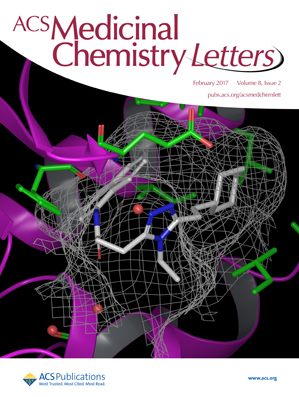发现 PARP1 蛋白质 ADP-核糖基化分离抑制剂
IF 3.5
3区 医学
Q2 CHEMISTRY, MEDICINAL
ACS Medicinal Chemistry Letters
Pub Date : 2024-10-30
DOI:10.1021/acsmedchemlett.4c0039510.1021/acsmedchemlett.4c00395
引用次数: 0
摘要
聚 ADP 核糖聚合酶(PARPs)能催化细胞 ADP 核糖基化,在人类健康中发挥着重要作用。PARP 抑制剂已成功应用于临床癌症治疗。然而,为了提高安全性,还需要特异的同工酶抑制剂。在这里,我们报告了意外发现的烟酰胺模拟物,它们能在微摩尔浓度下阻断非 PARP1 催化的 ADP-核糖基化。这些PARP1-sparing PARP抑制剂代表了ADP-核糖基化的第一类探针,揭示了PARPs的选择性抑制。本文章由计算机程序翻译,如有差异,请以英文原文为准。
Discovery of PARP1-Sparing Inhibitors for Protein ADP-Ribosylation
Poly-ADP-ribose polymerases (PARPs) that catalyze cellular ADP-ribosylation play important roles in human health. PARP inhibitors have found success in the clinic for cancer treatment. However, isoform-specific inhibitors are needed for improved safety. Here, we report the unexpected discovery of nicotinamide mimics that block non-PARP1-catalyzed ADP-ribosylation at micromolar concentrations. These PARP1-sparing PARP inhibitors represent first-in-class probes for ADP-ribosylation, shedding light on the selective inhibition of PARPs.
求助全文
通过发布文献求助,成功后即可免费获取论文全文。
去求助
来源期刊

ACS Medicinal Chemistry Letters
CHEMISTRY, MEDICINAL-
CiteScore
7.30
自引率
2.40%
发文量
328
审稿时长
1 months
期刊介绍:
ACS Medicinal Chemistry Letters is interested in receiving manuscripts that discuss various aspects of medicinal chemistry. The journal will publish studies that pertain to a broad range of subject matter, including compound design and optimization, biological evaluation, drug delivery, imaging agents, and pharmacology of both small and large bioactive molecules. Specific areas include but are not limited to:
Identification, synthesis, and optimization of lead biologically active molecules and drugs (small molecules and biologics)
Biological characterization of new molecular entities in the context of drug discovery
Computational, cheminformatics, and structural studies for the identification or SAR analysis of bioactive molecules, ligands and their targets, etc.
Novel and improved methodologies, including radiation biochemistry, with broad application to medicinal chemistry
Discovery technologies for biologically active molecules from both synthetic and natural (plant and other) sources
Pharmacokinetic/pharmacodynamic studies that address mechanisms underlying drug disposition and response
Pharmacogenetic and pharmacogenomic studies used to enhance drug design and the translation of medicinal chemistry into the clinic
Mechanistic drug metabolism and regulation of metabolic enzyme gene expression
Chemistry patents relevant to the medicinal chemistry field.
 求助内容:
求助内容: 应助结果提醒方式:
应助结果提醒方式:


